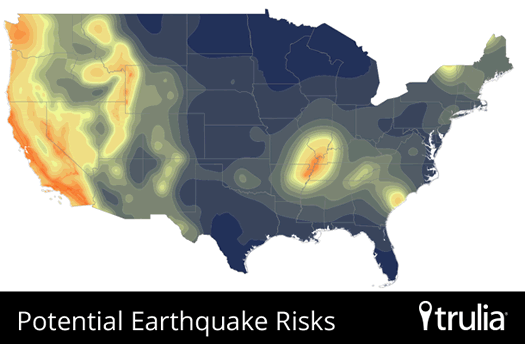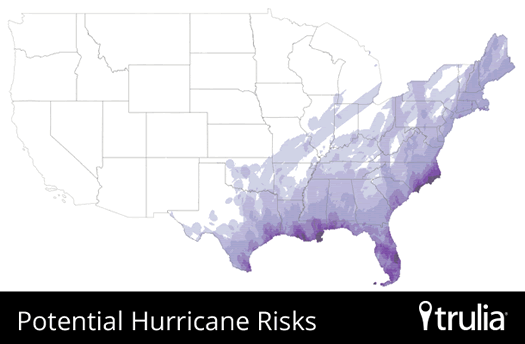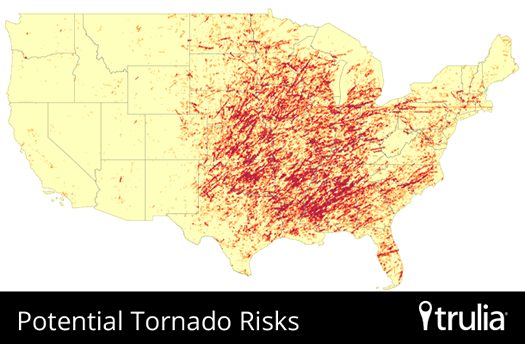Disasters, relatively speaking

Upstate New York is among the "lower-risk" areas of the country for natural disasters, according to calculations/maps created by Trulia. The real estate website has been rolling out natural hazard maps -- for earthquakes, hurricanes, tornadoes, wildfires, flooding -- for locations across the country. (Example: Here's the flooding risk map for Schoharie.)
Specifically, Syracuse and Buffalo were ranked among the top-10 lower-risk metros:
1. Syracuse, NY*
2. Cleveland, OH
3. Akron, OH
4. Buffalo, NY
5. Bethesda-Rockville-Frederick, MD
6. Dayton, OH
7. Allentown, PA-NJ
8. Chicago, IL
9. Denver, CO
10. Warren-Troy-Farmington Hills, MI
* Trulia note: The data on flood risk, which comes from the Federal Emergency Management Agency (FEMA), is incomplete for Syracuse and for several other metros not on the ten lower-risk list.
As Trulia points out, lower risk is not the same as no risk. And there are natural challenges beyond floods and earthquakes:
Notice that we're not calling these "safe" or "low-risk" metros. It's all relative, and every metro has some risk. Even the 10 lower-risk metros, above, all have some natural disasters in their distant or recent past. This ranking, and our hazard maps, are based on the best data available: recent government assessments of flood, earthquake, and wildfire risk, and years of historical data on hurricanes and tornadoes (all from the federal government, plus some earthquake data from the California Geological Survey). But disasters can be unpredictable. Even Buffalonians need to be prepared for the worst. ...
The 10 lower-risk metros for natural disasters have other crosses to bear. What upstate New York and northern Ohio lack in tornadoes and wildfires, they make up for in snow. While winter weather may be more predictable than earthquakes or hurricanes, harsh winters bring their own risks: blizzards, frostbite, and falling on the ice. Syracuse, Buffalo, Cleveland, Akron, and Denver are all among the snowiest large metros in the country.
As that clip above notes, the maps are based on data from the federal government. Of course, the map is only as good -- and as fine-grained -- as the data set from which it draws. And for some risks, like flooding, there are probably better, more-detailed maps.
The map at the top is Trulia's national picture of earthquake risk. Two more national maps -- for hurricanes and tornadoes -- are after the jump.
[via Atlantic Cities via Innovation Trail]


maps courtesy of Trulia
Hi there. Comments have been closed for this item. Still have something to say? Contact us.
Comments
I was an anxious kid growing up in town that tested its tornado sirens weekly. I also was terrified of visiting California, especially after the 89 Loma Prieta earthquake. On my one trip there, I was convinced the Big One would hit while we were riding Space Mountain and we'd all tumble into a crack in the earth. I never did ride Space Mountain. So when I moved to Albany I was pretty darn happy to live in an area with a low rate of disasters.
Of course, since I've been here I've felt two earthquakes (obviously nothing like what hit the Bay Area) and there have been a number of tornadoes over the years. But you're right to put it into perspective. Our winters are pretty brutal compared to much of the US. But at least we know those are coming every year and can prepare. Worst case scenario if the winter is mild? We're overstocked on wool socks. You can't really prepare for a tornado or earthquake. In that way, this area is good for people with anxiety issues from unpredictable natural disasters. We should work that into the city's motto. ALBANY: You probably* won't die from an earthquake.
*Although if the Ramapo Fault ever acts up you'll die a slow, painful death from the Indian Point nuclear fallout.
... said Valerae on Aug 19, 2013 at 4:35 PM | link
Homework assignment for aspiring cartographers: Overlay these natural disaster risk maps with last week's census "dot map" on AOA to plot how many people are at risk for what disaster.
... said Bob on Aug 19, 2013 at 4:40 PM | link
I always say that this is a great area to live in and one of the reasons is that our diasters are manageable. We usually see them coming and when they hit the number of people affected is usually small enough that they can receive timely assistance. I think CA is beautiful but I don't ever want to be on fire!
... said Chrissy on Aug 20, 2013 at 9:42 AM | link
Is it a coincidence that top 4 metro areas are also the least fun places to live in the entire Northeast?
... said Lu on Aug 20, 2013 at 11:06 AM | link